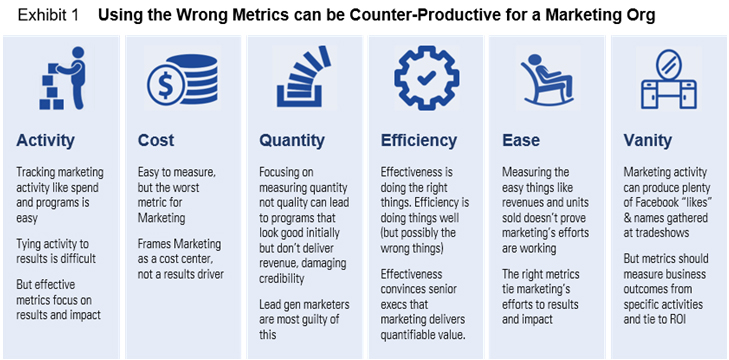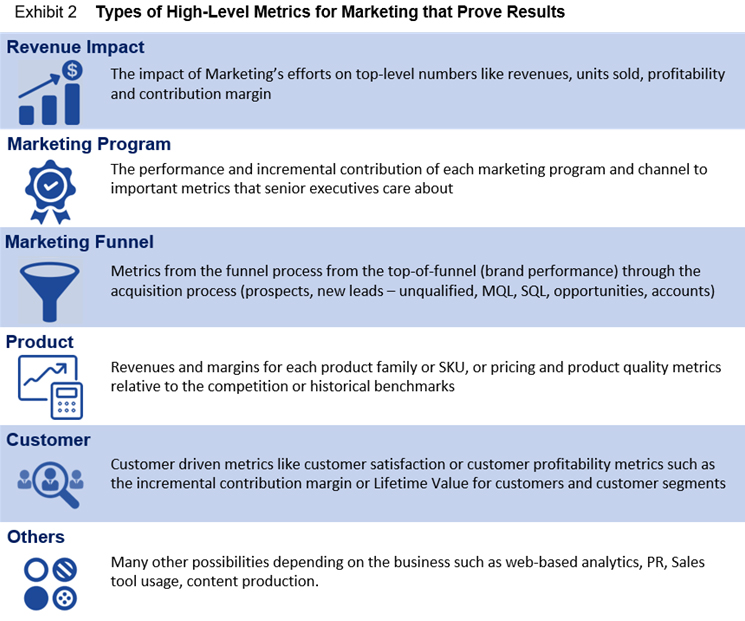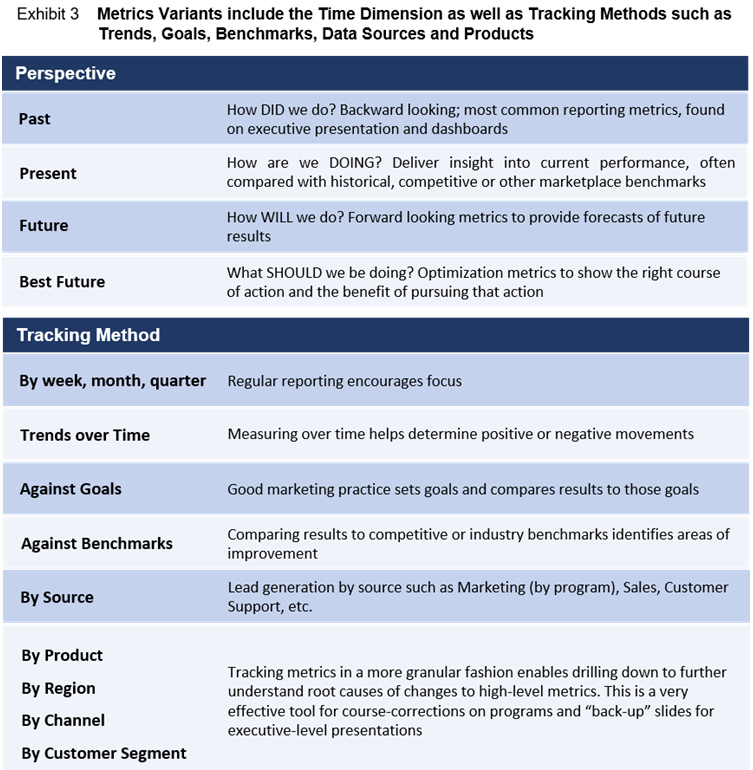Analytical Marketing
Section 6–Step Four: Implement Effective Metrics
By David Bartenwerfer
Metrics are a powerful tool for informing and guiding decision making at all levels of an organization. Quantitative measurement of performance helps leaders monitor the health of the business, and focus resources on the areas of greatest value. Metrics range from the mandatory — for regulatory, safety or contractual reasons — to those that track efficiency, productivity, performance, revenues/costs/profits and other successes/failures. Marketing metrics should support the strategies for all aspects of the organization; however, metrics can be detrimental if not designed and implemented properly. There are steps that marketing organizations can take to ensure the success of their metrics.
Choose the Right Metrics
The use of metrics is constantly evolving as the volume of information accelerates. More robust data from a broader array of sources coupled with new analytical tools to pull value from that data give organizations both more granular and more panoramic views of their business situation. That said, the opportunity to generate insights through data analytics is only as limited as the ability of your organization.
All metrics should be clear so that there is no ambiguity either internal or external to the organization. And, each measurement should augment Marketing’s understanding of how to make their programs and other activities better and to align those programs with the company’s strategic objectives. This way, even if the marketing team doesn’t meet all their goals, they can still figure out why and how to improve the program.
There will be opportunities to push the envelope. Usually organizations already have the data they need to undertake business initiatives, but many times leaders don’t know how they can leverage this information for decision-making. Marketing executives might not understand the potential value of the daily or hourly website or customer-service data that their company owns or be analytically adept enough to see the correlation to their campaigns to the likelihood of making a sale. Leaders can advance a guiding principle of using data, metrics and analytics in a more comprehensive fashion by focusing on the business problems and opportunities they need to address.
Don’t choose the Wrong Metrics
Caution should be taken however as sometimes metrics can give an inaccurate view of the business at best and damage the business or the marketing organization at worst. Ineffective metrics can be grouped into a couple of broad categories and can represent landmines that a marketing organization is wise to avoid. Exhibit 1 presents some categories of metrics that might be counter-productive to a marketing organization.

Get Buy-In
The successful implementation of any metric needs to receive buy-in from senior executives and employees alike. Senior executives need to lead the change of culture because changing the way organizations do their jobs will usually meet with some resistance. Linking some form of compensation to a new metric will drive organizational buy-in; however, organizations need to ensure that the proportion of compensation is commensurate with the importance of this metric in driving profits otherwise the leaders are sending a conflicting message to the troops.
In crafting metrics, Marketing needs to be particularly sensitive to their role in driving profits for the business, particularly that many in the broader organization see Marketing as a cost center, not a revenue driver. Consider a hypothetical example of the marketing team working hard to reduce the cost required to generate a lead. This looks like a clear success to the marketing team, so the CMO has a meeting with the CEO and CFO to request more budget for similar programs. The meeting takes a different turn when the CFO asks whether it would be financially more prudent to cut Marketing’s budget so that the number of leads stays the same and reallocate those funds to hiring more salespeople, who generate a measurable ROI. The mistake that Marketing made is that they have not done a good enough job in articulating the value to revenues for each lead they have generated.
The lesson here is that before any budget request takes place, anywhere in the company, leaders requesting those funds must be confident that they can tie those funds to some incremental profit gain. Operations does it, so does Sales, and Marketing is no different.Exhibit 2 presents a set of high-level metrics that every CMO should have ready when asked.

Understand Data Requirements
Data requirements have been covered in the previous section so no need to revisit here except to acknowledge that this is a critical step in the process. Additionally, all metrics need to give the same answer no matter who calculates it. They also need to be standardized, with data being collected in the same way across single or multiple departments, facilities and offices, nationally or internationally.
Measure and Share Best Practices
One pitfall that organizations generating new metrics may experience is that once the metrics are in place, the organization continues doing business in the same old way and the metrics don’t wind up having the impact that was anticipated. One way to manage that is to limit the number of any new metrics that are introduced at any one time — better to have three meaningful metrics that inspire organizations to change and get better than 30 that won’t have any incremental impact.
Organizations can improve by learning from others, and new metrics can help drive that. Employees should be encouraged to contact any other person in the company to ask how they are performing against the new metrics and what tactics they are employing to drive better numbers. Furthermore, if the organization has multiple locations, leaders should set up regular meetings to review progress, share experiences and successes, and discuss problems.
Creatively Evolve
Organizations will need to revise their metrics when the business needs or competitive landscape changes. The journey a customer takes to purchase (or defect) can change with new technology, strategies, or other factors. Also, the company might get so good at driving change with the new metrics, they might no longer challenge the organization.
Leaders should always be creatively considering the potential of external and new sources of data on ways to improve their business, and what metrics can be deployed to prove the impact of their efforts. Social media and search engines produce terabytes of unstructured data in the form of conversations, photos, and video. Add to that the flood of data generated by sensors, transactions and other processes, and external sources from RFID-enabled supply chains to psychographics.
The creative application of analytics can also drive new metrics. Consider the financial services company that wanted to assess the value of their branches as a guide to restructuring their network. Discussions with branch general managers and leadership provided all manner of reasons that branches exist but nothing to guide them in answering the key questions regarding branch location and expansion (or even contraction). But when branch data was consolidated with granular market share and geographic data it was found that the company’s market share was radically larger the closer the branch was to customers. Once that overall metric was defined, other variables could be investigated such as branch visibility, competitive pressures, wealth metrics and other demographics, etc. This enabled the branch team to reconfigure their branch network from fewer large branches in low visibility office parks to many smaller branches in highly trafficked retail geographies that both lowered costs and drove gains in market share.
One way to think creatively about evolving the way companies use data, metrics and analytics is to ask, “What decisions could we make if we had all the information we need?” Organizations should avoid getting bogged down in data and maintain the proper perspective of understanding the customer journey. Once Marketing starts measuring their impact on outcomes, they can identify gaps between their data and your business objectives. And, this increased transparency and accountability will make the marketing organization more valuable to the company.
Exhibit 3 presents some different variants that one can use to drill down further into these high-level metrics. Metrics should provide some sort of temporal perspective – whether they are from the past, present or future or even an optimized best future. And there are several methods that can be employed, such as the cadence, highlighting trends, against goals or benchmarks, and source- or product-specific metrics.

Why Marketing Programs are Difficult to Measure
When other departments invest, a relatively simple ROI analysis can be performed to justify the expenditure. Increased revenues demonstrate the impact of a new product; decreased costs prove the value of new machinery. But Marketing efforts are more complex and inter-dependent rendering such a simple analysis limited and incomplete. Most experts agree that it can take between seven and nine “touches” before a customer will actually make a purchase, requiring marketing programs to overlap and work together to increase the likelihood of an eventual sale.
Furthermore, marketing programs take time to have an effect. The money invested at one point in time can have an impact at an undetermined point in the future. Investments in advertising, events, or outbound marketing can deliver results next week or next year.
To add to the noise, large-ticket purchases in a B2B context are influenced by many different individuals in a prospect’s organization, and different marketing programs impact each individual influencer differently.
This complexity makes determining the individual impact of each program difficult to ascertain. Furthermore, marketing programs have multiple objectives and engage prospects at different stages of their decision process (or customer journey). And while these initiatives aren’t in conflict, their diverse natures make it challenging to objectively evaluate investment options.
A Word on Marketing ROI
Marketing orgs are facing demanding times. The emergence of Web 3.0 — social media sites like Facebook, YouTube, Twitter, and blogs — has changed the way consumers interact with brands.
As previous chapters in this group of articles have stated, even seasoned marketers may be overwhelmed to develop a competency around quantitative analysis while meeting conventional marketing demands. The good news is that both can be addressed with robust and holistic analytical frameworks that ensure marketing investments are properly measured and optimally allocated to drive the greatest revenue growth. And, ROI metrics are some of the most compelling metrics to use, particularly when speaking to the CEO and CFO.
So, Marketing organizations today must adapt by optimizing their resources across the new spectrum of marketing objectives. This can be accomplished most effectively through careful measurement and scrutiny of holistic ROI. A robust and holistic ROI approach builds on the marketing funnel concept and employs analytical tools to understand the changing value of prospects as they advance through the funnel. Marketers should create metrics and quantify the impact of the objective of each campaign. In so doing, they can better understand the ROI of their marketing investments at both granular and holistic levels and drive more value from their efforts.
Link to the next article in the sequence: Analytical Marketing 2.5 – Generate Insights with Analytics
Author
David Bartenwerfer is the founder and principal of Quantum Consulting and Technology. QuantumCT helps product and marketing organizations get smarter and prove, predict and optimize impact and ROI with economic and financial modeling that employs customizable algorithms and technology leading to fast and lasting insight and action. Mr. Bartenwerfer has over twenty years’ experience in the High Tech, Internet, Telecom, Media, Financial Services and Retail industries and holds a B.S. in Systems Engineering with minors in applied mathematics and economics from the University of Virginia and an M.B.A. from the Stanford Graduate School of Business. For further information, contact the author at davidbartenwerfer@quantumct.com.